Bridge Birds

Where are the Transmittered Bald Eagles?
March 14, 2017
Grace On Peninsula in Hampton as of March 18
March 20, 2017
Bridges often occupy a dominant position on the landscape overlooking extensive areas of open water or land. Due to their height and exposure they receive nearly constant winds. In many ways they mimic the conditions that attract nesting peregrines to coastal cliff sites throughout much of the world. In coastal Virginia where cliff formations are completely lacking, bridges have played a significant role in the recovery of the breeding population.
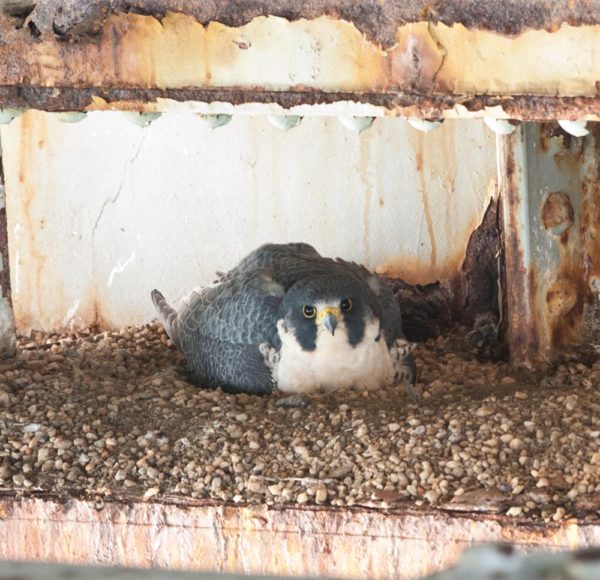
Female peregrine falcon incubating eggs on the Norris Bridge in Virginia. A pair has consistently nested on this bridge for 21 years. Photo by Libby Mojica.
Since 1993, bridges have consistently supported more than 30% (ranging up to as high as 50%) of the known breeding population of peregrine falcons in Virginia. The association began in the early spring of 1988 when a single peregrine was resident on the Coleman Bridge across the York River. Between 1988 and 2016, peregrines have been documented to use 15 different bridges including five that have been used for 18 years or more. During the 2016 breeding season, peregrines nested on 11 bridges.
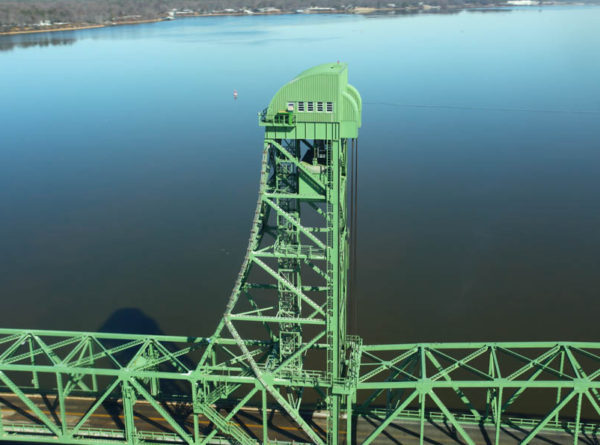
View of the north lift tower of the Benjamin Harrison Bridge in Virginia. The complex structure of these moveable bridges attracts nesting peregrines possibly because they offer multiple nest sites. During most years the resident pair nests within a nest box provided on the upper cat walk of the tower. Photo by Bryan Watts.
Supporting breeding peregrines on bridge structures has not been a completely benign relationship. Peregrines are protected by seasonal and spatial restrictions designed to improve breeding success. Restrictions have increased operational costs for bridges and caused concerns for bridge management and maintenance planning. Risks may be mitigated by knowing the occupancy status of a bridge in advance of bridge maintenance projects and by managing nesting birds away from operational areas or areas that require regular maintenance. Managing peregrine falcons on bridge structures has been a collaborative effort between the Virginia Department of Game & Inland Fisheries, The Center for Conservation Biology, and the Virginia Department of Transportation.
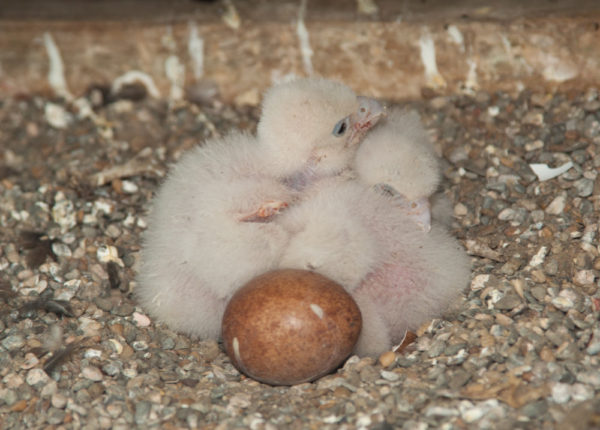
A young brood of peregrine falcons within a nest box on the James River Bridge in Virginia. Birds have nested on this bridge each season for 24 years. Nest boxes like this have been very successful in improving breeding performance. Photo by Bryan Watts.
During the 2016 breeding season CCB biologists, in collaboration with the Virginia Center for Transportation Innovation and Research and the Virginia Department of Transportation, surveyed 83 bridges in coastal Virginia for occupancy by peregrine falcons (download report). The primary objective of the project was to determine bridge occupancy that would reduce uncertainty in planning operations and maintenance activities. Additional objectives included the testing of a rapid survey protocol that may be used in future bridge surveys, the identification of bridge characteristics that attract falcon pairs that may be used in identifying bridges with high potential for colonization in the future, and a retrospective study of the effectiveness of falcon management techniques that have been and continue to be used on bridges in Virginia.
Eleven of the 83 bridges were determined to be used by peregrines in 2016, including two bridges that were previously unknown to support pairs. Response of birds to the taped calls used to survey bridges was dramatic with a more than 90% response rate by known pairs. Most birds responded to tapes immediately with 60% responding within 5 seconds and 80% responding within 10 seconds of tape initiation. Territorial birds called repeatedly and often circled around the tape. Occupied bridges were longer, embedded within more open landscapes, and had more potential nest sites compared to bridges that were not occupied. Lift or draw bridges were particularly sought after by peregrines, with eight of ten available moveable bridges being used for nesting over the past ten years. These bridge types have the highest availability of potential nest sites with overhead structures allowing peregrines to nest with protection from the weather.
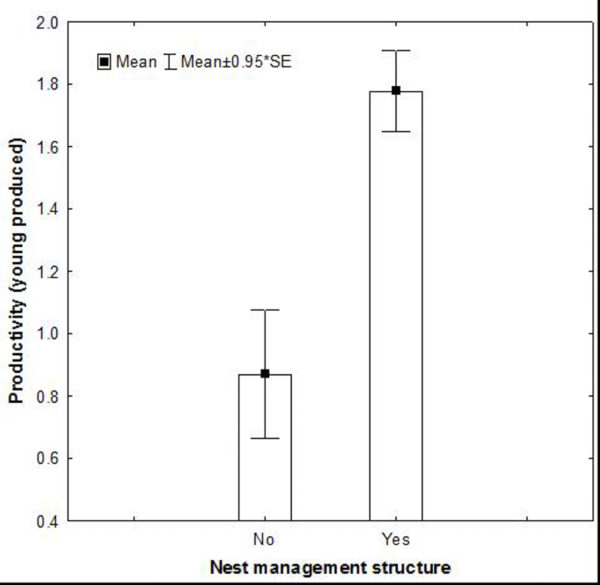
Comparison of mean productivity for peregrine falcons before (n = 38) and after (n = 117) management activities on bridges in Virginia. Breeding attempts used in the analysis included 12 bridges. Data from CCB.
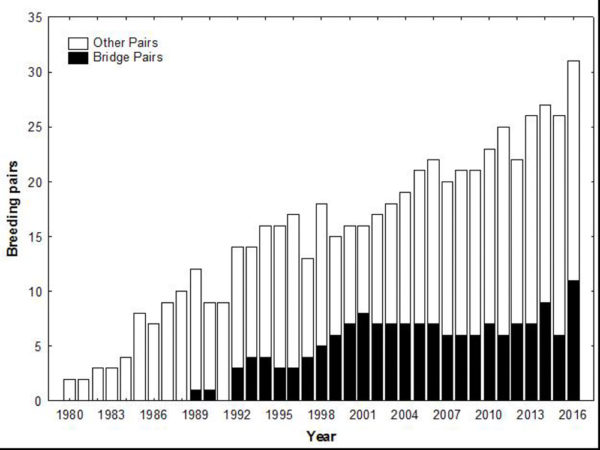
The number of breeding pairs of peregrine falcons in Virginia (1980-2016). Dark bars represent pairs nesting on bridges and open bars represent pairs on all other structures. Data from CCB.
One of the most satisfying findings of the retrospective investigation of peregrine management techniques used on Virginia bridges is how effectively they have improved breeding performance. When breeding performance is compared before and after nest boxes or trays were installed on bridges, peregrine pairs were more than twice as successful while using boxes, and successful pairs produced more than twice the number of young. The often overlooked benefit of using boxes to manage pairs is that they may frequently be used to entice pairs away from areas of the bridge that require regular maintenance. One of the clear conclusions of the study is that active pair management is beneficial to both the birds and to bridge operations.
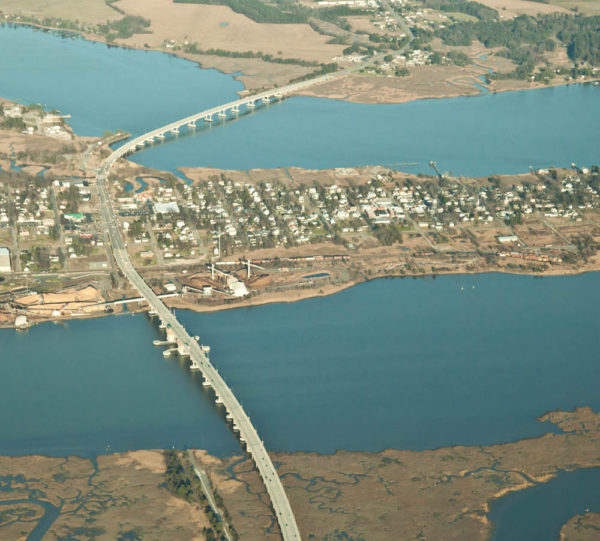
View of the Eltham Bridge (lower) across the Pamunkey River in Virginia. This moveable bridge is one of the most recent and lowest bridges used by nesting peregrines in the state. Photo by Bryan Watts.
Written by Bryan Watts | bdwatt@wm.edu | (757) 221-2247
March 17, 2017



